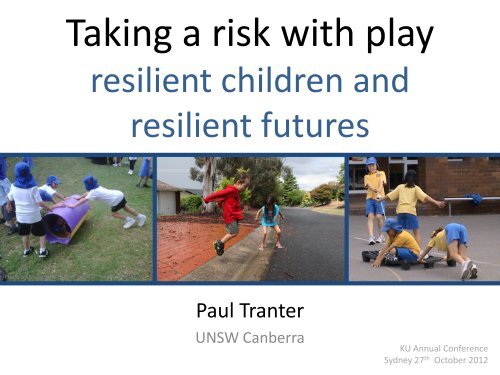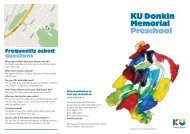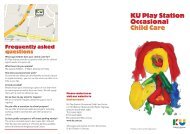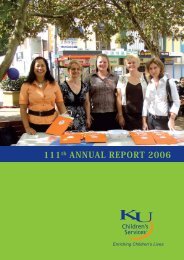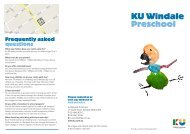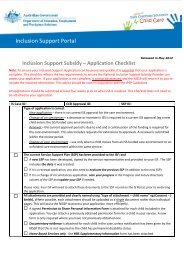Paul Tranter: Taking a risk with play - KU Children's Services
Paul Tranter: Taking a risk with play - KU Children's Services
Paul Tranter: Taking a risk with play - KU Children's Services
Create successful ePaper yourself
Turn your PDF publications into a flip-book with our unique Google optimized e-Paper software.
<strong>Taking</strong> a <strong>risk</strong> <strong>with</strong> <strong>play</strong>resilient children andresilient futuresPhoto by Maya Spitz<strong>Paul</strong> <strong>Tranter</strong>UNSW Canberra<strong>KU</strong> Annual ConferenceSydney 27 th October 2012
Your favourite <strong>play</strong> spaceas a seven year old child?Risks taken as a child?Minor injuries sustained during ‘<strong>risk</strong>y’ <strong>play</strong>?
Injury Prevention?
Low-stakes <strong>risk</strong>sSmall accident Photo by chdothhttp://www.flickr.com/photos/chdot/2085549687/
Deeper lessonsWe need communities where children can <strong>play</strong>fullyexplore their own neighbourhoods, and learnvaluable lessons about <strong>risk</strong> taking in the processPullde Hurdler: Photo by clappstarhttp://www.flickr.com/photos/clappstar/4437903454/
“Children needchallenge. Theyneed adventure.They needuncertainty. Andthey need <strong>risk</strong>.”
The value of <strong>risk</strong>Helps children learn how to manage <strong>risk</strong>sthemselvesA full second on two wheels by By Glenn Loos-Austinhttp://www.flickr.com/photos/junkchest/154558081/
The value of <strong>risk</strong>Risks outweighed by the health anddevelopmental benefits
There should always be a concern <strong>with</strong> freedom fromunacceptable <strong>risk</strong> of life-threatening or permanentlydisabling injury in <strong>play</strong>. However, there will always besome <strong>risk</strong> of injury when children <strong>play</strong>.
The value of <strong>risk</strong>Long-term benefits of <strong>risk</strong> encounters“… overcoming challenging situations is an essentialpart of living a meaningful and satisfying life”(Gill, 2007, 16)down she went by goat_girl_photoshttp://www.flickr.com/photos/goat_girl_photos/4719650660
“Rather than having a nanny state, whereregulation and <strong>risk</strong> aversion dominate thelandscape, we need to aspire to a childfriendlysociety”(Gill, 2007)
Child friendly societies?Dresden Photo by Greg Mews
Child friendly societies:United Nations Convention on theRights of the Child
Provision(survival and development)ProtectionParticipation
Provision rightsWater: A Precious Resource: Photo by niOShttp://www.flickr.com/photos/nios/3376170604/
Provision rightsArticle 31: the right to <strong>play</strong>Last one there is a rotten egg ByInspiredinDesMoineshttp://www.flickr.com/photos/w4nd3rl0st/5457200511/
Provision rightsFreedom to <strong>play</strong>fully explore their environmentChildren and Shadows: Photo by Abe Khttp://www.flickr.com/photos/abekleinfeld/5378999934/
Provision rightsFreedom to engage in <strong>risk</strong>y <strong>play</strong>?
Protection rightsBanksy Tunpike Lane London: Photo by Deptford.Jonhttp://www.flickr.com/photos/deptfordjon/7205314352/
Protection rightsRed by serakatiehttp://www.flickr.com/photos/serakate/401717360/
Protection rights“Children today walk less than ever before inthe history of humanity”(Roberts and Edwards, 2010, 39)boy in car by zenhttp://www.flickr.com/photos/zen/3856125/
Protection rightsExposure to low-stakes <strong>risk</strong>s
Protection rightsReduced lifestyle diseasesLeading by example Photo by Planetgordon.comhttp://www.flickr.com/photos/planetgordon/6202425306/
Participation rightsChildren as present citizens, not just future citizens
Participation rightsParticipating in community lifeCourtesy of TravelSmart Australia
If we get these right, we are well onthe way to creating resilient childrenand resilient societiesBoris leert fietsen by ianushttp://www.flickr.com/photos/ianus/102095174
What has happened to children’sopportunities for <strong>risk</strong>y <strong>play</strong> ascommunity cultures have changed?
Declines in children’s freedom to <strong>play</strong>
Changes in school grounds
More indoor and adult organised activitiesPhoto by Smellykneewww.flickr.com/photos/melanieburger/763569036/Photo by sean dreilingerhttp://www.flickr.com/photos/seandreilinger/2853798333/Photo by Enahmansonhttp://www.flickr.com/photos/enahmanson/446798616/Photo by ella novakhttp://www.flickr.com/photos/cookylida/3757900101/
Time pressured adults and children
“Children are not born obsessed <strong>with</strong> speedand productivity – we make them that way”(Honoré, 2004, 216 – 217)
Less outdoor space
Restrictive rules on children’s use of urban spaceNo ball games, Photo by Unityhttp://www.flickr.com/photos/we_need_unity/3749561721/
Social pressure on parents, teachersand child care workers
Less freedom to <strong>play</strong>fully exploretheir neighbourhoods
7060504030Walk to schoolCar to schoolBus to schoolOther201001971 1981 1991 1999-2003Mode of travel to school for children aged 5-9 inAustralia (Source: Van der Ploeg et al, 2008, 62)
Can we re-createopportunities for lowstakes <strong>risk</strong>s?
Changes to built environmentSchools, shops and services closer tochildren’s homes
Changes to built environmentIncreasing children’s safetyfrom traffic
Changes in social valuesRecognise the collective impacts of individualdecisions
Things we can doWaving and smiling at a speeding motorist
Things we can doThree things you can do to develop a stronglocal neighbourhood community …
1. Go for a walk around your neighbourhoodCourtesy of TravelSmart Australia
2. Go for a walk around your neighbourhood
3. Go for a walk around your neighbourhoodChris & Jessica Engagement: Photo by Auzigoghttp://www.flickr.com/photos/eyermonkey/2842941601/
Interventions in schoolgrounds and child carecentres
Sporting activities or supervised physicalactivity programs or adult organised games?• these are NOT <strong>play</strong>• many vigorous ‘active’games <strong>play</strong>ed bychildren involvechildren waiting turnWaiting in line 004 by tomyleeshttp://www.flickr.com/photos/71256895@N00/3929678256
Fixed <strong>play</strong> equipment?• Children get bored• Congregate underequipment
School ground greening programs?• Popular in Canada• Very effective in encouraging physical activityand contact <strong>with</strong> naturehttp://blog.evergreen.ca/category/school-ground-greening/page/2/
Green school grounds provide an abundanceof manipulable, natural loose materials,providing opportunities for imaginative,cooperative and construction <strong>play</strong>
Two major limitations of school groundgreening programs– expensive– a green school ground means little <strong>with</strong>out aphilosophical commitment to allowing children to<strong>play</strong>
An alternative interventionThe Sydney Playground Projecthttp://sydney.edu.au/health_sciences/sydney_<strong>play</strong>ground_project/
Sydney Playground Projectaims to increase children's physical activity,social skills and resilience through a simple,low cost intervention that is carried out on theschool <strong>play</strong>ground in primary school
Differences in children’s <strong>play</strong> inthese school grounds?
Encouraging more <strong>risk</strong> and <strong>play</strong> in theschool groundSurplus safety in the school ground?
http://sydney.edu.au/health_sciences/sydney_<strong>play</strong>ground_project/
http://sydney.edu.au/health_sciences/sydney_<strong>play</strong>ground_project/photo_album.shtml
Sydney Playground Project• 13 week intervention• 12 schools (6 control, 6 intervention)• Children aged 5-7 years
The interventionTwo components:• Risk reframing intervention <strong>with</strong> parents andteachers• Introducing loose materials to the school<strong>play</strong>ground:– car tyres, milk crates, bread crates, buckets, crashmats, conduit piping, and pool noodles
Risk ReframingEncouraging adults toconsider the <strong>risk</strong>s ofNOT letting children<strong>play</strong>Bored children by zen http://www.flickr.com/photos/zen/241745451/
Risk ReframingAdults were asked to reflect on their ownchildhood experiences, and compare the“<strong>risk</strong>y” activities they engaged in <strong>with</strong> thelevel of <strong>risk</strong> that they allow their children totakeBillyCart-3 by Mred32http://www.flickr.com/photos/mred32/2586650446/
Introducing loose materials to the school<strong>play</strong>ground
Allowing children to take <strong>risk</strong>s in <strong>play</strong>Physical activity and teamwork: boyjumping off a bread crate onto acrash mat
Allowing children to take <strong>risk</strong>s in <strong>play</strong>Physical activity: childrenpushing a barrel <strong>with</strong> anotherchild inside
Allowing children to take <strong>risk</strong>s in <strong>play</strong>Creativity: physical activity, cooperative <strong>play</strong>
Change in the social hierarchy on the school ground
‘Risky’ <strong>play</strong> <strong>with</strong> loose materials led to reductions infighting and bullying, <strong>with</strong> no increase in accident injuryCreative <strong>play</strong> and physical activity: buckets for helmets and noodles for swords
These simple interventions, which could beadopted in every primary school, have thepotential of initiating a self-sustaining cycle ofprevention for childhood obesity, bullying andmental ill healthCould they also work in pre-schools and childcarecentres?
http://www.youtube.com/watch?v=nqi1KyJJeKg&feature=youtu.be
http://www.youtube.com/watch?v=nqi1KyJJeKg&feature=youtu.be
http://www.youtube.com/watch?v=nqi1KyJJeKg&feature=youtu.be
http://www.youtube.com/watch?v=nqi1KyJJeKg&feature=youtu.be
Should we consider the <strong>risk</strong>that there is no <strong>risk</strong>?
Lessons from childrenabout creating resilientfuturesTo achieve a fundamentalcultural change - reviveinnate values that alreadyexist <strong>with</strong>in our childrenBy taking the time to observeour children, we may rediscover:
The joys of slownessThe value ofcommunity andworking togetherThe excitement of<strong>risk</strong>
Creating resilient children and resilientfutures? It’s child’s <strong>play</strong>.
Thank you<strong>Paul</strong> <strong>Tranter</strong>UNSW Canberra
References:Bundy, A., Naughton, G., <strong>Tranter</strong>, P., Wyver, S., Baur, L., Schiller, W., Bauman,A., Engelen, L., Ragen, J. & Luckett, T. 2011. The Sydney PlaygroundProject: Popping the bubblewrap-unleashing the power of <strong>play</strong>: a clusterrandomized controlled trial of a primary school <strong>play</strong>ground-basedintervention aiming to increase children's physical activity and social skills.BMC Public Health, 11, 1, 680.CHILDREN'S PLAY COUNCIL, U. 2002. Managing Risk in Play Provision: APosition Statement [Online]. Available:http://www.<strong>play</strong>england.org.uk/media/120462/managing-<strong>risk</strong>-<strong>play</strong>-safetyforum.pdf.Engwicht, D. (2005) Mental Speed Bumps: the Smarter Way to Tame Traffic,Envirobook, SydneyGill, T. (2007) No Fear: Growing Up in a Risk Averse Society, London, CalousteGulbenkian Foundation. http://www.gulbenkian.org.uk/pdffiles/--item-1266-223-No-fear-19-12-07.pdfGill, T. (2011) The end of zero <strong>risk</strong> in childhood?, The Guardian, Sunday 3 July.Freeman, C. and <strong>Tranter</strong>, P. (2011) Children and their Urban Environment,London, Earthscan.Van Der Ploeg, H., Merom, D., Corpuz, G., Bauman, A., 2008. Trends inAustralian children traveling to school 1971–2003: Burning petrol orcarbohydrates? Preventive Medicine 46, 60–62


